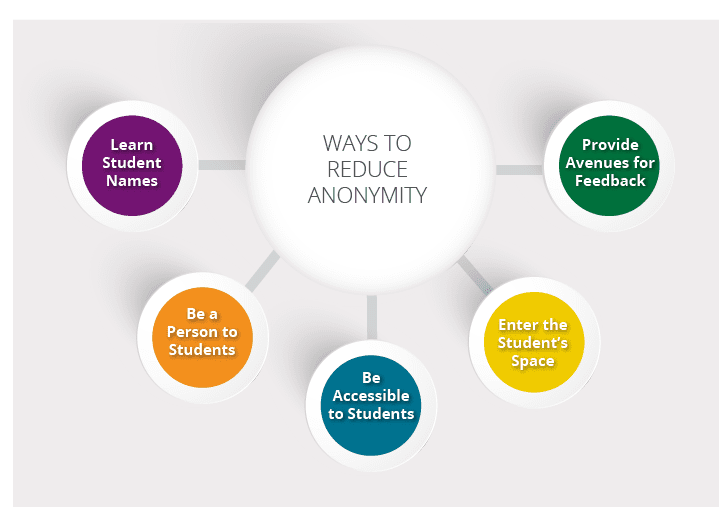Teaching Large Classes
Making a Large Class Small
Large-enrollment courses present a number of unique challenges that can impede students’ learning and exhaust faculty members teaching the class. To get a glimpse of the challenges, we have asked UNC Charlotte students what they have to say about large classes in three short, entertaining videos
Video Q&A with UNC Charlotte Students
- What do you like about large classes? [3:45, YouTube]
- What do you dislike about large classes? [3:17, YouTube]
- What improvements would you like to see in large classes? [3:57, YouTube]
How Can I Reduce the Feeling of Student Anonymity?

Learn Student Names: Create a seating chart to enable rapid taking of attendance and identification of students. Return exams personally to associate names with faces and encourage students who are struggling. Before class, learn the names of people sitting along the aisles and call on them during the class. When giving a test, I ask the students to hang a sheet of paper with their names in large letters in front of them and you can wander around the room learning names. When handing back the tests, go to the labs or discussion sections with the papers and hand each back individually with an appointment book to invite students with scores of D or less to make an appointment, and any others who look disappointed or concerned.
Be a Person to Students: Create a more personal environment by letting students “know” you in appropriate ways. Tell about your interests and hobbies. Explain how you first encountered a concept or how you used course-related materials in problem-solving.
Be Accessible to Students: Try to find ways to be accessible to students on a personal level. Arrive early and chat with students who are already there. Greet students as they come in and give them opportunities to ask questions they might not ask during class. Stay a few minutes after class to answer individual questions. Give students your email address and encourage them to send questions or comments in this way. Pass out invitations to 10 students to join you for coffee after class to get acquainted. Announce that you’ll meet any students who are free for coffee after class (you won’t be swamped).
Enter the Student’s Space: Consider lecturing or leading discussion from different points of the classroom to give students the feeling of being in the midst of the action rather than simply being an observer. Standing behind a podium emphasizes the distance between you and the class. Moving into the aisles and around the room makes the class seem smaller and encourages student involvement.
Provide Avenues for Feedback: Ask students at intervals to write down the “muddiest” part of your lecture, and then use some of the next class or handouts to clarify the material. A class-specific newsgroup on the campus computer network can foster out-of-class discussion.
Use Active Learning Techniques
Make your classes interactive. You may want to use clickers. UNC Charlotte has an institutional license contract with Poll Everywhere as its designated and standardized Student Response System (SRS). As a standardized system, Poll Everywhere will be the only supported and recognized polling system at UNC Charlotte. Students will now receive a free Poll Everywhere license allowing them to respond to polling questions in their courses.
Use ‘low risk techniques’ such as clarification pause, daily journal, fishbowl, muddiest point, one minute paper, note-taking pairs, creating quiz/ test questions, response to a demonstration or other teacher centered activity, round robin, student summary of another student’s answer, think pair share.
Use Moderate to advanced techniques such as active review sessions, affinity grouping, case study, concept mapping, cooperative groups in class
Grading Considerations
Consider an assignment that can have a low impact on student grades such as a short in-class paper and marking them as ‘satisfactory’ or ‘unsatisfactory’ rather than an A, B, C etc.
Balance the use of essays vs. multiple choice questions. Well written, quality multiple-choice questions take time to write but can be graded quickly whereas essays can be written quickly but take time to grade.
Practical Issues
Because large classes usually require a rigid schedule, ensure your students are aware of the schedule
Consider using online tools such as Canvas for announcements and handouts. Students can access handouts online if they miss class. Put handouts online far enough in advance so students can print the out before class.
Make announcements via email so students are more likely to get them.
Additional Resources:
- Working with TAs (Cornell University)
This web page lists tips on working with TAs including benefits and barriers of collaborating with TAs. - Five Principles of Successful Course Redesign (The National Center for Academic Transformation)
This web page describes five principles of college course redesign, including example redesign projects and descriptions of how the principles improve student learning and reduce instructional cost. - Six Innovative Course Redesign Practices (The National Center for Academic Transformation)
This web page describes six innovative practices that were employed in college course redesign projects, including example redesign projects.